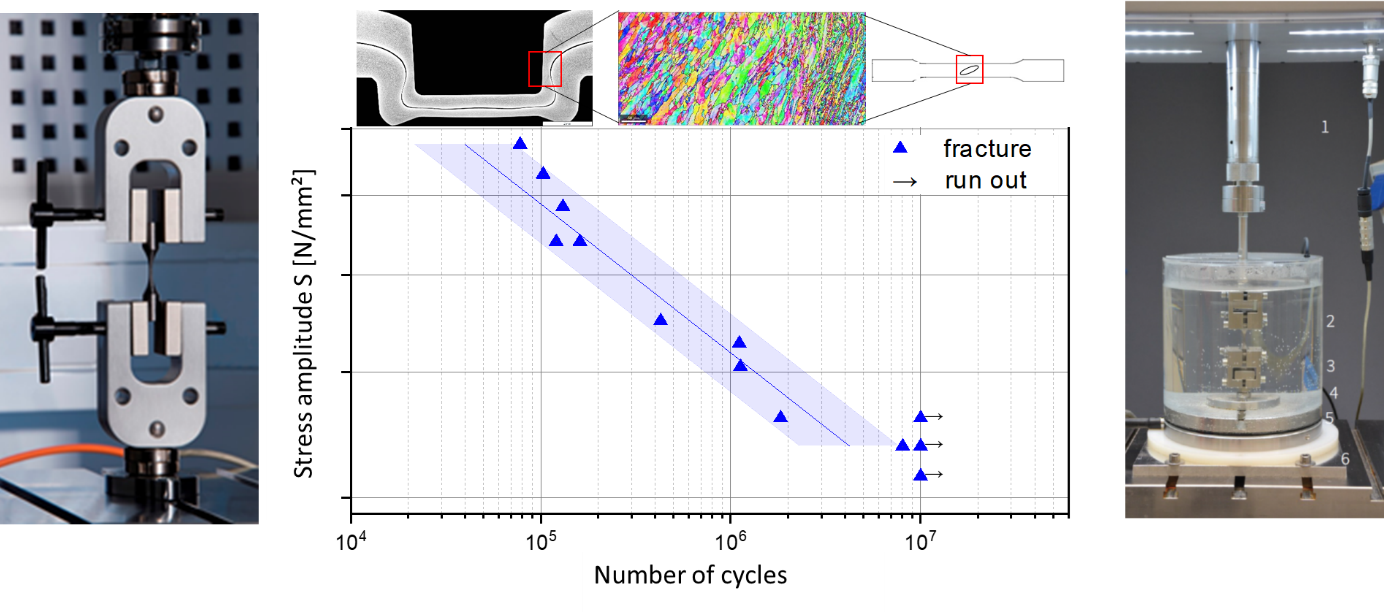B02 - Reliability of joints concerning cyclic mechanical loading and corrosive environment
The subproject addresses the fatigue and corrosion behavior of the joints treated in the TRR. The characterization of the reliability of mechanically joined structures has so far been carried out primarily on a phenomenological basis. Therefore, the transferability of the findings and characteristic values beyond the respective joint and the associated process window to other joints is only possible to a limited extent. The fatigue strength investigated purely phenomenologically is subject to strong fluctuations as a function of the sheet thickness, the parameters for producing the joint, the loading scenario, and the joint quality. However, versatile process chains (e.g., changed sheet thickness, process parameter variation) require precisely a process parameter-independent and thus fundamental understanding of the damage evolution in a clinched joint. The basic idea of the versatility of joints is to be taken into account by an extended consideration of the interdependencies between the base material condition, the joining process and the resulting material and structural properties and thus a generalizable prediction of the reliability of versatile joints with the associated process parameter adjustments. Thus, especially for predicting the fatigue behavior, a fundamentally new approach is necessary, which enables the path from the F-N-curve to the S-N-curve under consideration of notch effects and the microstructure. The goal of a material physics-based characterization of the strength properties to be investigated here requires a separate analysis of the decisive influencing factors: local notch geometry in the most highly stressed area of the joint, deformation state as a result of the joining process and surface condition. Thus, the main focus is on the influence of the plastic deformation input during the joining process and the resulting geometric notch on the fatigue and corrosion behavior. The development and testing of new specimens serve to separately analyze the influence of multiaxial plastic deformation and the associated microstructural changes on the one hand and the influence of the geometric notch on the other hand on the fatigue behavior with and without the effect of a corrosive medium. The failure-critical characteristic variables identified in this way are combined based on statistical evaluation methods and ultimately lead to developing a service life prediction concept for clinched joints based on material- and process-based parameters for versatile process chains.
Zuverlässigkeit
Publications
Untersuchungen zum Einfluss von Geometrieparametern bei artgleichen Al-Clinchverbindungen auf das Ermüdungsverhalten im Bereich hoher bis sehr hoher Lastspielzahlen
L. Ewenz, S. Schettler, A.T. Zeuner, M. Zimmermann, Tagung Werkstoffprüfung 2020. Werkstoffe Und Bauteile Auf Dem Prüfstand. Prüftechnik - Kennwertermit (2020).
Effect of Different Tool Geometries on the Mechanical Properties of Al-Al Clinch Joints
L. Ewenz, J. Kalich, M. Zimmermann, U. Füssel, Key Engineering Materials 883 (2021) 65–72.
Numerical and experimental identification of fatigue crack initiation sites in clinched joints
L. Ewenz, C.R. Bielak, M. Otroshi, M. Bobbert, G. Meschut, M. Zimmermann, Production Engineering 16 (2022) 305–313.
Effect of the tool geometry on microstructure and geometrical features of clinched aluminum
L. Ewenz, M. Kuczyk, M. Zimmermann, Journal of Advanced Joining Processes 5 (2022).
Corrosion Phenomena and Fatigue Behavior of Clinched Joints: Numerical and Experimental Investigations
S. Harzheim, L. Ewenz, M. Zimmermann, T. Wallmersperger, Journal of Advanced Joining Processes 6 (2022).
The Influence of Heat Treatment on the Microstructure, Surface Roughness and Shear Tensile Strength of AISI 304 Clinch Joints
A.T. Zeuner, L. Ewenz, J. Kalich, S. Schöne, U. Füssel, M. Zimmermann, Metals 12 (2022).
Clinching of Aluminum Materials – Methods for the Continuous Characterization of Process, Microstructure and Properties
R. Kupfer, D. Köhler, D. Römisch, S. Wituschek, L. Ewenz, J. Kalich, D. Weiß, B. Sadeghian, M. Busch, J.T. Krüger, M. Neuser, O. Grydin, M. Böhnke, C.R. Bielak, J. Troschitz, Journal of Advanced Joining Processes 5 (2022).
Numerical and experimental identification of fatigue crack initiation sites in clinched joints
L. Ewenz, C.R. Bielak, M. Otroshi, M. Bobbert, G. Meschut, M. Zimmermann, Production Engineering 16 (2022) 305–313.
Anrisserkennung an geclinchten Proben während einer zyklischen Belastung unter Nutzung eines Scanning Laser Doppler Vibrometers
A. Brosius, L. Ewenz, R. Stephan, M. Zimmermann, in: M. Zimmermann (Ed.), Tagung Werkstoffprüfung 2022, Deutsche Gesellschaft für Materialkunde e.V. (DGM), 2023.
Ableitung flacher Probengeometrien zur Abbildung mehraxialer Spannungszustände in Clinchverbindungen unter zyklischer Beanspruchung
L. Ewenz, M. Kuczyk, S. Schöne, M. Zimmermann, in: M. Zimmermann (Ed.), Tagung Werkstoffprüfung 2022, Deutsche Gesellschaft für Materialkunde e.V. (DGM), 2023.
Untersuchungen zum Geometrie- und Frequenzeinfluss bei der Ermittlung zyklischer Kennwerte geclinchter Überlappverbindungen
L. Ewenz, R. Kühne, S. Schöne, M. Zimmermann, in: M. Zimmermann (Ed.), Tagung Werkstoffprüfung 2022, Deutsche Gesellschaft für Materialkunde e.V. (DGM), 2023.
Show all publications


